A lot of what we do here at Uscreen is researching and testing new ways of increasing your membership revenue to help you grow your business.
And, a long-time experiment with one of our features has been a real game-changer.
All the way back at the start of 2021, we rolled out a Subscription Upsell feature for our existing customers to test out. This feature allows you to invite potential members to consider subscribing for a longer period of time right before they complete their checkout.
More specifically, it prompts potential monthly members to sign up for a discounted annual membership. And, the results have been incredible!
Since it launched in 2021, Subscription Upsells has generated $2.5 million in additional revenue (for the mere 18% of our customers who have the feature enabled)!
But, how quickly could the feature start showing results for you?
In this article, we’re going to break down exactly what this marketing strategy is, why it works, and how you can start using it in your membership business right away.
Let’s go…
The Marketing Strategy That Helped Uscreen Customers Earn 553.8% More In 4 Months
On the 20th of January 2021, we rolled out the new upsell feature to a percentage of our existing customers for their video membership sites. Of the sample group, 278 implemented it into their sales funnel.
They each followed a specific process:
- They targeted leads who wanted to purchase a monthly membership.
- They prompted them before they reached the checkout page.
- They offered a discounted upgrade to their annual package.
And, spoiler, they saw a 553.8% increase in revenue in the first 4 months of 2021 alone. That’s 6.5X growth!
Here’s how one of the upsell prompts looks like in action, from Coaches Voice Academy:
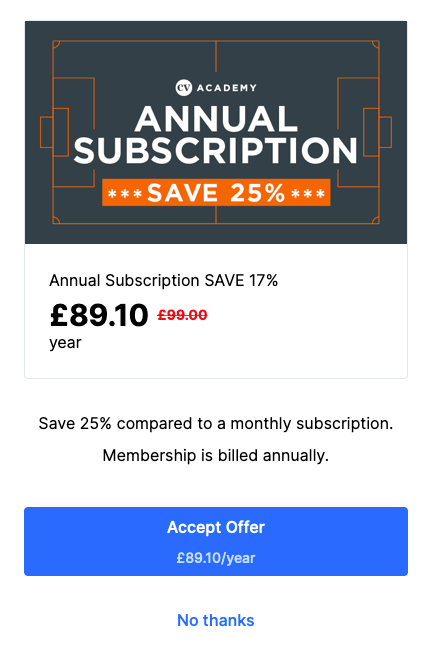
We’ll get a little more into the psychology of why they followed these exact steps later on in this article. For now, let’s look at the results of using the upsell feature in 4 months…
Without the upsell offers, these 278 membership businesses would have attracted enough monthly subscribers to generate a combined total of $107,788.98 in revenue.
But:
When potential members were presented with the upsell offer, 5251 people chose to upgrade their package to an annual membership. This took the combined total income generated by our customers to $704,811.44.
That means a total of $597,022.46 extra revenue was generated across all customers in just 4 months. (Or, a 558.8% increase!)
Better still, this upsell feature was easy to implement and can be set to run on auto-pilot to continuously generate income for the long term.
Our customer, MyTRIBE, swears by upsells as a staple strategy to this day.
Uscreen’s upsell feature was a game-changer! I even reworked my advertising strategy and my landing pages around it. I now funnel everyone into the monthly plan and let the upsell feature do the work. It took our revenue and our subscribers through the roof!
Jason David, MyTRIBE
Now, before we get into the details, we need to address the big discount-offer-shaped elephant in the room…
Discounts: A Proven Way To Increase The Lifetime Value Of Your Members
It’s common for discounts to make you feel like you’re going to make less money. You probably felt a pang of worry when you saw us suggest it earlier.
But, unlike the eCommerce industry, discounts can actually generate more revenue for a subscription business like yours!
It sounds counterintuitive, so let’s make sense of why it works.
Converting a new customer to a discounted annual membership will generate more income than converting them with a higher-priced monthly membership. And, we can prove it.
Take a look at the numbers…
The average length of a monthly user’s membership (aka retention time period) is between 3 and 6 months before they churn. (You can see accurate average figures for your industry in the table below.)
| Industry | Avg. Retention Time Period (Months) |
|---|---|
| eLearning & Instructional | 4.7 |
| Entertainment | 5.8 |
| Yoga & Meditation | 4.4 |
| Faith & Spirituality | 5.7 |
| Health & Fitness | 4.2 |
| Sports | 3 |
| Other | 4.8 |
This means their “lifetime” as a customer is much less than your annual subscription period. In fact, it hovers around 50% of it.
So:
If you’re an eLearning video business that offers a $10 monthly subscription, the predicted average lifetime value (LTV) of a potential monthly subscriber is $47. ($10 x 4.7 months)
Monthly subscription fee x Retention Time Period (Months) = Lifetime Value (LTV)
$10 x 4.7 months = $47
Now, let’s say you prompt that potential customer to upgrade from a monthly subscription to an annual one. And you do it at a discounted rate of $7 per month. How does that look?
Discounted annual subscription fee x 12 months = New Lifetime Value (LTV)
$7 x 12 months = $84
The new lifetime value of that customer is $84. You just gained $37 in income from that one member alone, because they will pay $7 for a total of 12 months.
The monthly fee is lower, but the total income generated is higher because you’re going to retain them as an existing customer for a longer period than you probably otherwise would have.
Better still…
That money is paid upfront and is guaranteed for the lifetime of that customer. Even if this only converts 10 extra members a month for our example eLearning membership site, that’s an immediate increase of nearly $400 a month.
And the reality is:
We’ve seen our customers convert 50 to 100 members a month with this upsell offer. That’s a lot of additional lifetime value!
Also, have we mentioned that the renewal rate for annual memberships is 16% higher than monthly memberships?
But why does this all work, and will your members actually go for it?
The answer is yes; let’s take a closer look at why.
Scarcity & FOMO: Why Upsells Make Your Members Buy More
Upselling strategies have been tried and tested by the marketing and sales world.
They work by tapping into some primal psychological elements that influence how we buy new products and perceive their value.
Let’s say you’re a newlywed looking to learn more about successful marriages. You’ve come across XO Now and are interested in signing up for one of their packages.
You’re unsure about what package to choose so you opt for the low-commitment monthly membership because, even though it’s a higher monthly cost, you can cancel anytime.
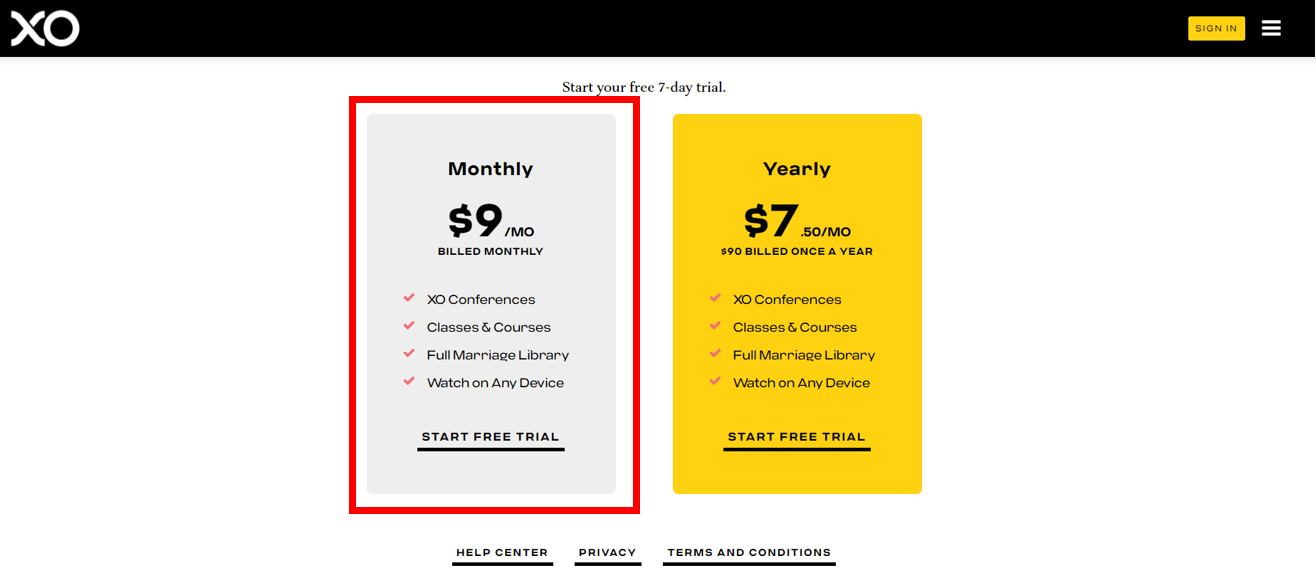
When you make this decision you go into what’s known as “purchasing mode.” You know you’re going to spend money here. But, there is a subconscious question you’re also asking:
How much am I going to spend?
Because you’ve committed to spending money and you want the content behind their paywall, you’re open to negotiation, as long as the deal feels worth it and you get more value from it.
This is a great time for XO Now to present you with an upsell option. Which is exactly what they do. They show you an offer for their annual membership at a reduced price:
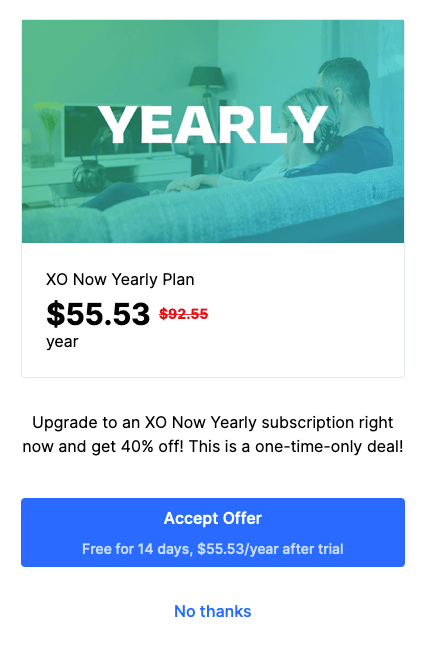
This offer will trigger some core emotions that will make you reconsider and evaluate the decision you’re about to make, like:
- Desire: you want this product, and you want the best deal.
- Scarcity: if you miss this deal now, it’ll be gone forever.
- FOMO: what will happen if you miss out on this deal?
It will also trigger the reward sections of the brain that you associate with sales and discounts. It’s much easier to rationalize a purchase when you’re saving money on it.
This means you’re now seriously considering swapping your low-commitment $9 payment for a much longer commitment at the higher $55.53 price point.
This is exactly what XO Now did and successfully converted 293 customers from monthly to annual membership plans in the 1st quarter of 2021.
Automatic upsell features like this can be a powerful way to generate extra income for your membership video service without adding to your workload.
In the next section, we’re going to show you how to create these upsells in Uscreen.
How To Create Powerful Upsell Offers In Uscreen
The Subscription Upsell feature is under the Marketing Tools tab of your Uscreen dashboard.
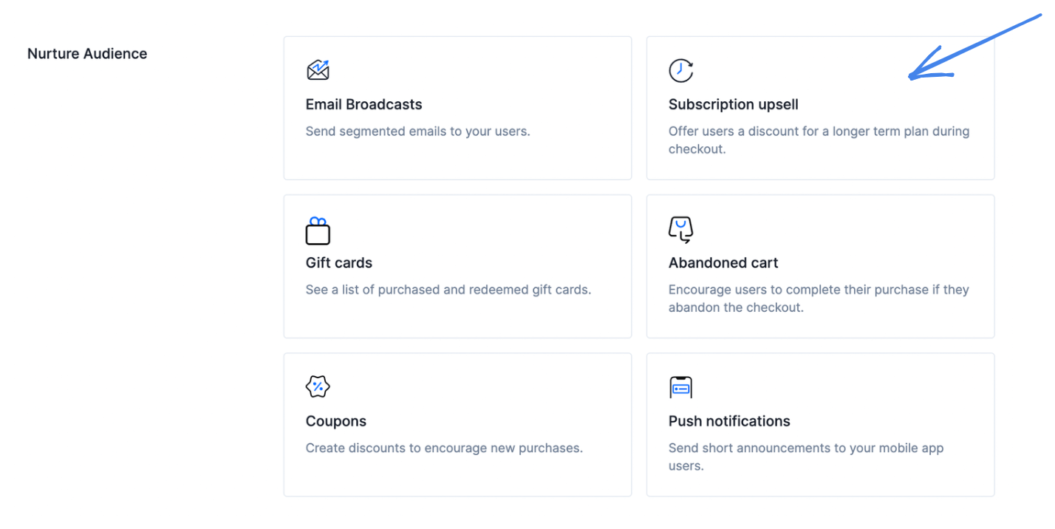
Here you’ll be able to access the feature’s full functionality and input all of the details – such as discounts and membership options – that will round out your upsell offer.
For the actual step-by-step tutorial on how to create your upsell, you can check out our how-to in our help guides.
In this section, I’m going to talk about the key ingredients you need to create a powerful upsell product.
Let’s go…
1. Offer At Least 2 Membership Plans
You’ll need to be offering your customers at least these 2 membership plans.
- Monthly: a recurring package at a higher monthly price point.
- Annual: a package billed annually at a lower monthly price point.
These 2 options should be clearly displayed on your website, ready to convert members with just one click. You could even add a Quarterly membership as FLY LDN Online has here:
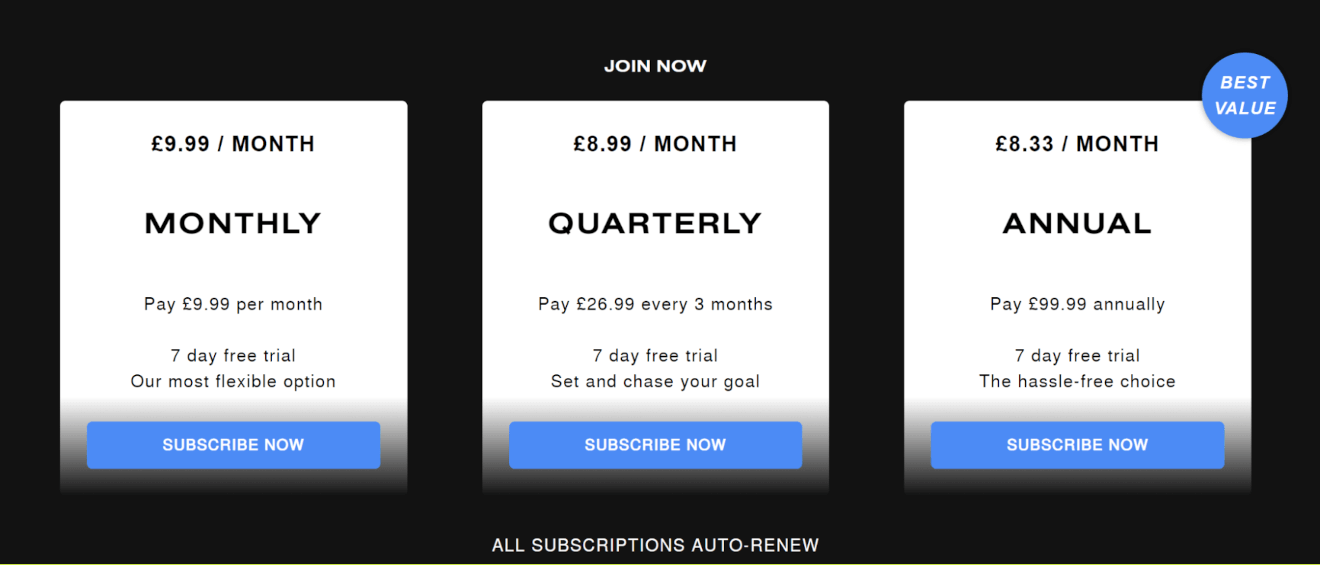
It’s important that your potential customers can see the normal price of your annual plan. This will increase the psychological impact of the discounted offer later on.
2. Create An Impactful Discount Offer
Identify a discount for your annual offer that works for you (and your customer base).
The offer needs to be powerful enough to make your customers stop and think. They should feel like a discount this good will only happen once!
Based on our internal data, here are the suggested minimum and maximum discount offers for your industry’s subscription plans:
| Industry | Min. Suggested Discount | Max. Suggested Discount |
|---|---|---|
| Elearning & Instructional | 30% | 50% |
| Entertainment | 20% | 40% |
| Yoga & Meditation | 30% | 50% |
| Faith & Spirituality | 20% | 40% |
| Health & Fitness | 30% | 50% |
| Sports | 40% | 60% |
| Other | 30% | 50% |
3. Have A Strong Membership Upsell Pop-Up
To really trigger those emotions, you’re going to need to pay attention to the words and phrasing – otherwise known as copywriting – in your offer.
The key here is to:
- Emphasize the urgency of the deal.
- Show them how much they’re going to save.
- Create a strong call-to-action.
The good news is that you can do all of this with just a few carefully crafted sentences.
Because these potential customers are already sold on your product, you can avoid rehashing information and get straight to the benefits of upgrading their membership.
You can see how Cheer Live has done this here:
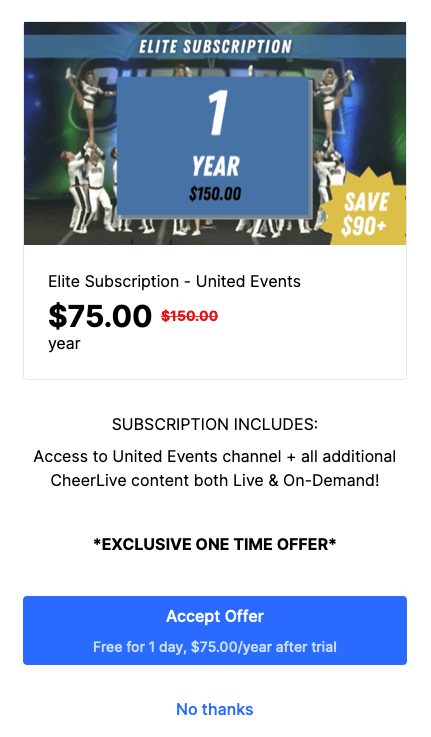
To do this yourself, you should:
- Highlight 2-3 key benefits of your upgrade options (what they stand to gain).
- Focus on the discount (what they stand to save).
- Remind them this is a one-time offer (create urgency).
Which will lead them directly to your call-to-action to upgrade their membership.
Wrapping This Up…
Upsells are an incredible way to boost your membership income on autopilot. In just 4 months we saw it drive 553.8% more income across our customers’ membership businesses, and that growth has only continued since then!
If you want to see how to set up an upsell offer for your Uscreen video website, you can go straight to our help guide here.
We love seeing our additional features drive so much growth for our customers.
If you have any success stories, we’d love to hear from you. Share them with us over on Instagram!







